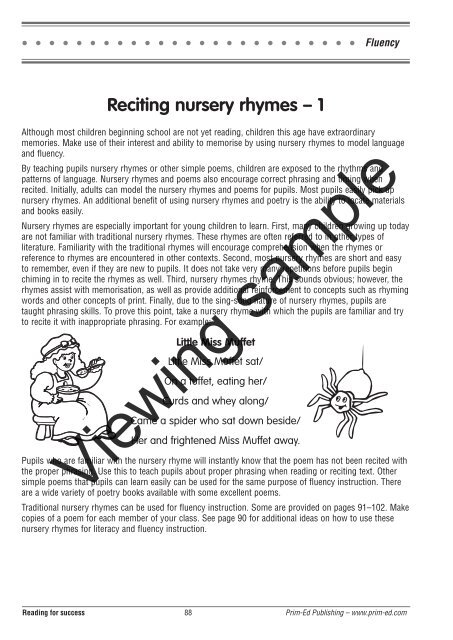PR-6216IRE Reading For Success - Book 1
You also want an ePaper? Increase the reach of your titles
YUMPU automatically turns print PDFs into web optimized ePapers that Google loves.
Fluency<br />
Reciting nursery rhymes – 1<br />
Although most children beginning school are not yet reading, children this age have extraordinary<br />
memories. Make use of their interest and ability to memorise by using nursery rhymes to model language<br />
and fluency.<br />
By teaching pupils nursery rhymes or other simple poems, children are exposed to the rhythms and<br />
patterns of language. Nursery rhymes and poems also encourage correct phrasing and timing when<br />
recited. Initially, adults can model the nursery rhymes and poems for pupils. Most pupils easily pick up<br />
nursery rhymes. An additional benefit of using nursery rhymes and poetry is the ability to locate materials<br />
and books easily.<br />
Nursery rhymes are especially important for young children to learn. First, many children growing up today<br />
are not familiar with traditional nursery rhymes. These rhymes are often referred to in other types of<br />
literature. Familiarity with the traditional rhymes will encourage comprehension when the rhymes or<br />
reference to rhymes are encountered in other contexts. Second, most nursery rhymes are short and easy<br />
to remember, even if they are new to pupils. It does not take very many repetitions before pupils begin<br />
chiming in to recite the rhymes as well. Third, nursery rhymes rhyme. This sounds obvious; however, the<br />
rhymes assist with memorisation, as well as provide additional reinforcement to concepts such as rhyming<br />
words and other concepts of print. Finally, due to the sing-song nature of nursery rhymes, pupils are<br />
taught phrasing skills. To prove this point, take a nursery rhyme with which the pupils are familiar and try<br />
to recite it with inappropriate phrasing. <strong>For</strong> example:<br />
Little Miss Muffet<br />
Little Miss Muffet sat/<br />
On a tuffet, eating her/<br />
Curds and whey along/<br />
Came a spider who sat down beside/<br />
Her and frightened Miss Muffet away.<br />
Viewing sample<br />
Pupils who are familiar with the nursery rhyme will instantly know that the poem has not been recited with<br />
the proper phrasing. Use this to teach pupils about proper phrasing when reading or reciting text. Other<br />
simple poems that pupils can learn easily can be used for the same purpose of fluency instruction. There<br />
are a wide variety of poetry books available with some excellent poems.<br />
Traditional nursery rhymes can be used for fluency instruction. Some are provided on pages 91–102. Make<br />
copies of a poem for each member of your class. See page 90 for additional ideas on how to use these<br />
nursery rhymes for literacy and fluency instruction.<br />
<strong>Reading</strong> for success 88 Prim-Ed Publishing – www.prim-ed.com


















